A symmetrical lattice is a
two-port
A two-port network (a kind of four-terminal network or quadripole) is an electrical network ( circuit) or device with two ''pairs'' of terminals to connect to external circuits. Two terminals constitute a port if the currents applied to them sat ...
electrical wave
filter
Filter, filtering or filters may refer to:
Science and technology
Computing
* Filter (higher-order function), in functional programming
* Filter (software), a computer program to process a data stream
* Filter (video), a software component tha ...
in which diagonally-crossed
shunt elements are present – a configuration which sets it apart from
ladder networks. The component arrangement of the lattice is shown in the diagram below. The filter properties of this circuit were first developed using
image impedance Image impedance is a concept used in electronic network design and analysis and most especially in filter design. The term ''image impedance'' applies to the impedance seen looking into a port of a network. Usually a two-port network is implied but ...
concepts, but later the more general techniques of
network analysis Network analysis can refer to:
* Network theory, the analysis of relations through mathematical graphs
** Social network analysis, network theory applied to social relations
* Network analysis (electrical circuits)
A network, in the context of e ...
were applied to it.
There is a duplication of components in the lattice network as the "series impedances" (instances of ''Z''
a) and "shunt impedances" (instances of ''Z''
b) both occur twice, an arrangement that offers increased flexibility to the circuit designer with a variety of responses achievable. It is possible for the lattice network to have the characteristics of: a delay network,
[Weinberg L., "Network Analysis and Synthesis", McGraw Hill 1962, (p. 633)] an amplitude or phase correcting network, a dispersive network or as a linear phase filter,
[Guillemin E.A., Communication Networks, Vol II", Wiley N.Y., 1935] according to the choice of components for the lattice elements.
Configuration
The basic configuration of the symmetrical lattice is shown in the left-hand diagram. A commonly used short-hand version is shown on the right, with dotted lines indicating the presence the second pair of matching impedances.
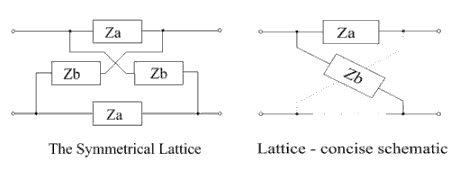
It is possible with this circuit to have the characteristic impedance specified independently of its transmission properties, a feature not available to ladder filter structures. In addition, it is possible to design the circuit to be a
constant-resistance network A constant-resistance network in electrical engineering is a network whose input resistance does not change with frequency when correctly terminated. Examples of constant resistance networks include:
* Zobel network
* Lattice phase equaliser
* Bouc ...
for a range of circuit characteristics.
The lattice structure can be converted to an unbalanced form (see below), for insertion in circuits with a ground plane. Such conversions also reduce the component count and relax component tolerances.
[Bode H.W., "Network Analysis and Feedback Amplifier Design", Van Nostrand, N.Y., 1945]
It is possible to redraw the lattice in the
Wheatstone bridge
A Wheatstone bridge is an electrical circuit used to measure an unknown electrical resistance by balancing two legs of a bridge circuit, one leg of which includes the unknown component. The primary benefit of the circuit is its ability to provide ...
configuration
[Campbell G.A., "Physical Theory of the Electric Wave-Filter", BSTJ, Vol. I, No. 2, Nov. 1922, (pp. 1–32).] (as shown in the article
Zobel network : ''For the wave filter invented by Zobel and sometimes named after him see m-derived filters.''
Zobel networks are a type of filter section based on the image-impedance design principle. They are named after Otto Zobel of Bell Labs, who pub ...
). However, this is not a convenient format in which to investigate the properties of lattice filters, especially their behavior in cascade.
Basic properties
Results from image theory
Filter theory was initially developed from earlier studies of transmission lines. In this theory, a filter section is specified in terms of its
propagation constant
The propagation constant of a sinusoidal electromagnetic wave is a measure of the change undergone by the amplitude and phase of the wave as it propagates in a given direction. The quantity being measured can be the voltage, the current in a ci ...
and
image impedance Image impedance is a concept used in electronic network design and analysis and most especially in filter design. The term ''image impedance'' applies to the impedance seen looking into a port of a network. Usually a two-port network is implied but ...
(or characteristic impedance).
Specifically for the lattice, the propagation function, , and characteristic impedance,
o, are defined by,
[
: and
Once and o have been chosen, solutions can be found for and from which the characteristics of a and b
can each be determined. (In practice, the choices for and o are restricted to those which result in physically realisable impedances for a and b .)
Although a filter circuit may have one or more pass-bands and possibly several stop-bands (or attenuation regions), only networks with a single pass-band are considered here.
In the pass-band of the circuit, the product is real (i.e. o is resistive) and may be equated to o, the terminating resistance of the filter. So
: or (for frequencies in the passband)
That is, the impedances behave as duals of each other within this frequency range.
In the attenuation range of the filter, the characteristic impedance of the filter is purely imaginary, and
: (for frequencies in the attenuation band)
Consequently, in order to achieve a specific characteristic, the reactances within a and b are chosen so that their resonant and anti-resonant frequencies are duals of each other in the passband, and match one another in the stopband. The transition region of the filter, where a change from one set of conditions to another occurs, can be made as narrow as required by increasing the complexity of a and b . The phase response of the filter in the pass-band is governed by the locations (spacings) of the resonant and anti-resonant frequencies of a and b .
For convenience, the ''normalised parameters'' o and o are defined by
: and
where normalised values and have been introduced. The parameter o is termed the ''index function'' and o is the ''normalised characteristic impedance'' of the network. The parameter o is approximately in the attenuation region; o is approximately in the transmission region.][
]
Cascaded lattices
All high-order lattice networks can be replaced by a cascade of simpler lattices, provided their characteristic impedances are all equal to that of the original and the sum of their propagation functions equals the original.[ In the particular case of all-pass networks (networks which modify the phase characteristic only), any given network can always be replaced by a cascade of second-order lattices together with, possibly, one single first order lattice.][
Whatever the filter requirements being considered, the reduction process results in simpler filter structures, with less stringent demands on component tolerances.][
]
The shortcomings of image theory
The filter characteristics predicted by image theory require a correctly terminated network. As the necessary terminations are often impossible to achieve, resistors are commonly used as the terminations, resulting in a mismatched filter. Consequently, the predicted amplitude and phase responses of the circuit will no longer be as image theory predicts. In the case of a low-pass filter, for example, where the mismatch is most severe near the cut-off frequency, the transition from pass-band to stop-band is far less sharp than expected.
The figure below illustrates the issue: A lattice filter, equivalent to two sections of constant low-pass filter, has been derived by image methods. (The network is normalised, with and so and The left-hand figure gives the lattice circuit and the right-hand figure gives the insertion loss
In telecommunications, insertion loss is the loss of signal power resulting from the insertion of a device in a transmission line or optical fiber and is usually expressed in decibels (dB).
If the power transmitted to the load before inserti ...
with the network terminated (1) resistively, and (2) in its correct characteristic impedances.
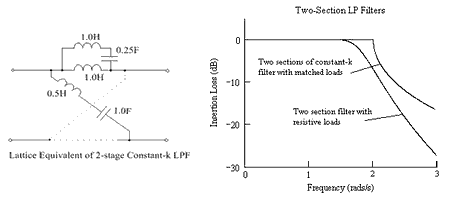 To minimise the mismatch problem, various forms of image filter end terminations were proposed by Zobel and others, but the inevitable compromises led to the method falling out of favour. It was replaced by the more exact methods of network analysis and
To minimise the mismatch problem, various forms of image filter end terminations were proposed by Zobel and others, but the inevitable compromises led to the method falling out of favour. It was replaced by the more exact methods of network analysis and network synthesis
Network synthesis is a design technique for linear electrical circuits. Synthesis starts from a prescribed impedance function of frequency or frequency response and then determines the possible networks that will produce the required response. ...
.[ ]
Results derived by network analysis
This diagram shows the general circuit for the symmetrical lattice:
 Through
Through mesh analysis
Mesh analysis (or the mesh current method) is a method that is used to solve planar circuits for the currents (and indirectly the voltages) at any place in the electrical circuit. Planar circuits are circuits that can be drawn on a plane sur ...
or nodal analysis
In electric circuits analysis, nodal analysis, node-voltage analysis, or the branch current method is a method of determining the voltage (potential difference) between " nodes" (points where elements or branches connect) in an electrical circuit i ...
of the circuit, its full transfer function can be found. That is,
The input and output impedances ( and ) of the network are given by
These equations are exact, for all realisable impedance values, unlike image theory where the propagation function only predicts performance accurately when and are the matching characteristic impedances of the network.
The equations can be simplified by making a number of assumptions. Firstly, networks are often sourced and terminated by resistors of the same value so that and the equations become
Secondly, if the impedances and are duals of one another, so that , then further simplification is possible:
so such networks are constant-resistance networks.
Finally, for normalised networks, with ,
If the impedances and (or the normalised impedances and ) are pure reactances, then the networks become all-pass, constant-resistance, with a flat frequency response but a variable phase response. This makes them ideal as delay networks and phase equalisers.
When resistors are present within and then, provided the duality condition still applies, a circuit will be constant-resistance but have a variable amplitude response. One application for such circuits is as amplitude equalisers.
Conversions and equivalences
(See references[Conning S.W., "A Survey of Network Equivalences", Proc. IREE, Australia, June 1969, (pp. 166–184)])
T to lattice

Pi to lattice
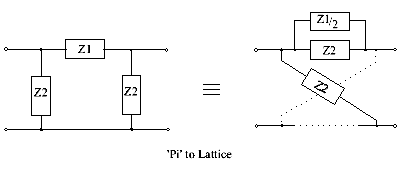
Common series element

Common parallel element
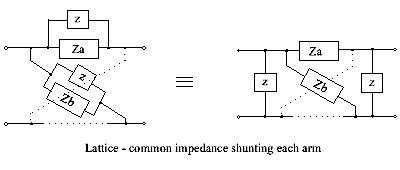
Combining two lattices into one
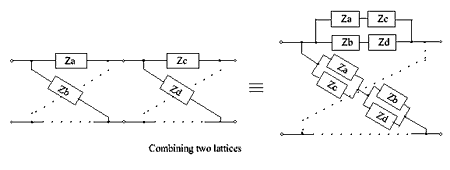
Lattice to ''T'' (see also the next section)
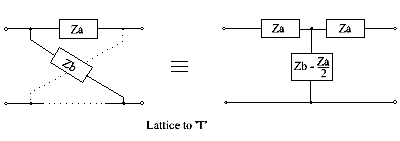 This lattice-to-T conversion only gives a realisable circuit when the evaluation of gives positive valued components. For other situations, the bridged-T may provide a solution, as discussed in the next section.
This lattice-to-T conversion only gives a realisable circuit when the evaluation of gives positive valued components. For other situations, the bridged-T may provide a solution, as discussed in the next section.
Unbalanced equivalents
The lattice is a balanced configuration which is not suitable for some applications. In such cases it is necessary to convert the circuit to an electrically equivalent unbalanced form. This provides benefits, including reduced component count and relaxed circuit tolerances. The simple conversion procedure shown in the previous section can only be applied in a limited set of conditions – generally, some form of bridged-T circuit is necessary. Many of the conversions require the inclusion of a 1:1 ideal transformer,Bartlett's bisection theorem
Bartlett's bisection theorem is an electrical theorem in network analysis Network analysis can refer to:
* Network theory, the analysis of relations through mathematical graphs
** Social network analysis, network theory applied to social relation ...
,[Bartlett A.C., "The Theory of Electrical Artificial Lines and Filters", Chapman & Hall, 1930] an unbalanced bridged-T circuit is achieved.
In the left-hand figure, the Za arm has a shunt capacitor, Ca, and the Zb arm has a series capacitor, Cb. Consequently, Za consists of Ca in parallel with Za′, and Zb consists of Cb in series with Zb′. This can be developed into the unbalanced bridged-T shown, provided .
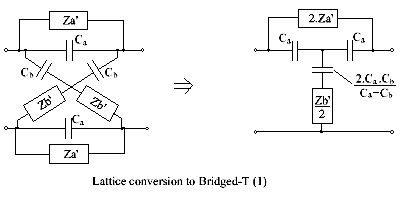 (An alternative version of this circuit has the T configuration of capacitors replaced by a Pi (or Delta) arrangement. For this T to Pi conversion, see the equations in
(An alternative version of this circuit has the T configuration of capacitors replaced by a Pi (or Delta) arrangement. For this T to Pi conversion, see the equations in Attenuator (electronics)
An attenuator is an electronic device that reduces the power of a signal without appreciably distorting its waveform.
An attenuator is effectively the opposite of an amplifier, though the two work by different methods. While an amplifier ...
).
When , an alternative procedure is necessary, where common inductors are first extracted from the lattice arms. As shown, an inductor ''L''a shunts ''Z''a′ and an inductor ''L''b is in series with ''Z''b′. This leads to the alternative bridged-T circuit on the right.
If , then the negative-valued inductor can be achieved by means of mutually coupled coils. To achieve a negative mutual inductance, the two coupled inductors L1 and L2 are wound 'series-aiding'.
 So finally, the bridged-T circuit takes the form
Bridged-T circuits like these may be used in delay and phase-correcting networks.
Another lattice configuration, containing resistors, is shown below. It has shunt resistors Ro across the Za’s and series resistors Ro as part of the Zb's, as shown in the left hand figure. It is easily converted to an unbalanced bridged-T circuit, as shown on the right.
So finally, the bridged-T circuit takes the form
Bridged-T circuits like these may be used in delay and phase-correcting networks.
Another lattice configuration, containing resistors, is shown below. It has shunt resistors Ro across the Za’s and series resistors Ro as part of the Zb's, as shown in the left hand figure. It is easily converted to an unbalanced bridged-T circuit, as shown on the right.
 When ''Z''1''Z''2 = R02 it becomes a constant resistance network, which has an insertion loss given by
When normalized to 1ohm, the source, load and R0 are all unity, so Z1.Z2 = 1, and the insertion loss becomes
In the past, circuits configured in this way were very popular as amplitude equalisers. For example, they were used to correct for the high frequency losses in telephone cables
When ''Z''1''Z''2 = R02 it becomes a constant resistance network, which has an insertion loss given by
When normalized to 1ohm, the source, load and R0 are all unity, so Z1.Z2 = 1, and the insertion loss becomes
In the past, circuits configured in this way were very popular as amplitude equalisers. For example, they were used to correct for the high frequency losses in telephone cables[Zobel O.J,, "Distortion Correction in Electrical Circuits with Constant Resistance Recurrent Networks”, BSTJ, Vol. 7, No. 3, July 1928, (pp. 438–534)] and in long runs of coaxial cable for television installations.
An example, showing the design procedure for a simple equaliser, is given in the section on synthesis, later.
All-pass networks
(See previously quoted references to Zobel, Darlington, Bode and Guillemin. Also see Stewart and Weinberg.)Foster's reactance theorem
Foster's reactance theorem is an important theorem in the fields of electrical network analysis and synthesis. The theorem states that the reactance of a passive, lossless two-terminal (one-port) network always strictly monotonically increases ...
.
The two simplest all-pass networks are the first and second order lattices. These are important circuits because, as Bode pointed out,
Lattice synthesis
Network synthesis is the process of deriving a circuit to match a chosen transfer function. Not all transfer functions can be realized by physical networks, but for those that can, the lattice network is always a solution. In other words, if a symmetrical two-terminal pair network is realizable at all, it is realizable as a lattice network.[Guillemin E.A., “Synthesis of Passive Networks”, Wiley, N.Y., 1957][van Valkenburg M.E., “Introduction to Modern Network Synthesis”, J. Wiley, N.Y., 1960.] This is because the lattice structure is the most general form of a network, with fewer constraints than, say, T, П or bridged-T networks.
Once a lattice circuit has been developed, it is often desirable to convert the result into an unbalanced form,[Lewis II P.M., “The Synthesis of Voltage Transfer Functions”, MIT Technical Report 314, June 1956. Find at https://dspace.mit.edu/bitstream/handle/1721.1/4768/RLE-TR-314-04734634.pdf?] or if a combination of circuits in parallel is considered.
Synthesis with z parameters
z-parameters, or Impedance parameters Impedance parameters or Z-parameters (the elements of an impedance matrix or Z-matrix) are properties used in electrical engineering, electronic engineering, and communication systems engineering to describe the electrical behavior of linear electr ...
, are one set from the family of parameters that define a two-port network, with input and output values defined by ''I''1, ''I''2, ''V''1 and ''V''2,[Mattheai G.L., Young L. and Jones E.M.T., “Microwave Filters, Impedance-Matching Networks, and Coupling Structures”, McGraw Hill 1964, Artch House 1980] as shown in the figure.
 Equations defining network behaviour in terms of z-parameters are
where the z-parameters are defined under open circuit conditions (see
Equations defining network behaviour in terms of z-parameters are
where the z-parameters are defined under open circuit conditions (see Impedance parameters Impedance parameters or Z-parameters (the elements of an impedance matrix or Z-matrix) are properties used in electrical engineering, electronic engineering, and communication systems engineering to describe the electrical behavior of linear electr ...
) so they are sometimes referred to as "open-circuit parameters".
They are defined thus
Example 1
Consider ''z''12 to be given by
Synthesis from the open-circuit transfer function
The open-circuit voltage-ratio transfer function ''T'' can be obtained in terms of ''z''11 and ''z''12,
Example 2
Derive a lattice network with voltage-ratio transfer function T2 given by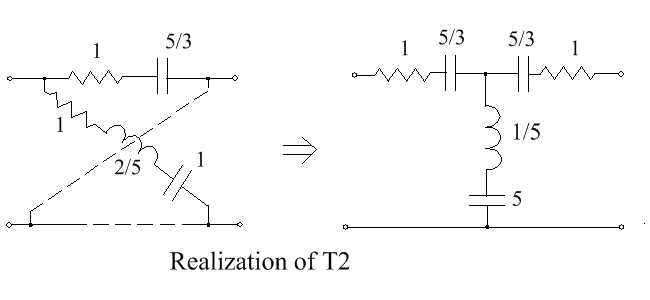
Example 3
An L-C circuit has a transfer function ''T''3 given by
This is realizable with ''K'' = 0.05,
Darlington synthesis
The Darlington method forms the basis for synthesis of lossless two terminal-pair networks with resistive termination for prescribed transfer characteristics.
Example 4
Consider a network with ''Z''I given by
So,
So solutions for ''z''11, ''z''22 and ''z''12 are
i.e. ''z''11 is an inductor of 1.6229H in series with a capacitor of 1.18F.
i.e. ''z''22 is an inductor of 1.1246H in series with a capacitor of 1.18F
By extracting a series inductance of 0.4983''p'' = (1.6229''p'' – 1.1246''p'') from ''z''11, the remaining network becomes symmetrical with
The components of a symmetrical lattice can be calculated from ''Z''a = ''z''11 − ''z''12 and ''Z''b = ''z''11 + ''z''12.
So i.e. an inductor of 0.9993H.
and i.e. an inductor of 1.2499H in series with a capacitor of 0.59F
The circuit is shown in the left hand figure below. It can be easily converted into the unbalanced form shown in the right hand figure. It is a low-pass filter with pass-band ripple of 1.25 dB, with −3 dB at 0.169 Hz, a null in the stop band at 0.414 Hz, and stop-band attenuation beyond the null frequency below −40 dB.

Synthesis of constant-resistance lattice networks
If the impedances Za and Zb are duals, and normalised, so that
then the image impedance ZI becomes a pure resistance. A symmetrical lattice fulfilling this condition is a "constant resistance lattice".
Such a lattice, terminated in 1 ohm, is shown below.
 This has the transfer function
in which T is the transfer impedance with a 1-ohm load in contrast to the open-circuit transfer impedance z21. Rearranging this, gives
The constant resistance lattice is thus seen to offer a possible approach to the synthesis of transfer functions.
It is the case that a constant resistance lattice is no less general than any other lattice, which means that any realizable transfer impedance can be realized in the form of a constant resistance lattice,.
This has the transfer function
in which T is the transfer impedance with a 1-ohm load in contrast to the open-circuit transfer impedance z21. Rearranging this, gives
The constant resistance lattice is thus seen to offer a possible approach to the synthesis of transfer functions.
It is the case that a constant resistance lattice is no less general than any other lattice, which means that any realizable transfer impedance can be realized in the form of a constant resistance lattice,.[ Such networks are very convenient, because there is no mismatch between sections or with resistive terminations. Consequently, the overall insertion loss of a cascade of constant resistance sections is simply to sum total of the individual sections. Conversely, a given complicated transfer impedance may be decomposed into multiplicative factors, whose individual lattice realizations, when connected in cascade, represent a synthesis of that transfer impedance. So, although it is possible to synthesize a single lattice with complicated impedances Za and Zb, it is practically easier to construct and align a cascade of simpler circuits.
]
All-pass constant-resistance networks
All-pass networks have a constant gain with frequency, but they have a phase response which varies in some chosen manner. For example, in the case of lattice delay network Lattice delay networks are an important subgroup of lattice networks. They are all-pass filters, so they have a flat amplitude response, but a phase response which varies linearly (or almost linearly) with frequency. All lattice circuits, regardless ...
s, the phase response is linear with frequency over a specified frequency range, whereas in the case of Lattice phase equaliser
A lattice phase equaliser or lattice filter is an example of an all-pass filter. That is, the attenuation of the filter is constant at all frequencies but the relative phase between input and output varies with frequency. The lattice filter top ...
s, the phase response of the network deviates so as to compensate for the non-linear phase response of a filter network.
The first and second order networks are the most important because, as Bode
Example 5
The all-pass response of the first order is
This has a zero located at +c and a pole at –''c'' in the complex frequency plane. It has a response where the phase varies with frequency, but the magnitude of ''T''5 is unity at all frequencies.
Using the expression for ''Z''a as a function of ''T'', from earlier, gives
So ''Z''a is an inductance with value 1/''c'' and, consequently, ''Z''b is a capacitor of value 1/''c''. The network, normalised to 1 ohm, is shown in the left-hand figure below.
Example 6
The all-pass response of the second order is
This has two zeroes located at and two poles at where ''a'' = 2''x'' and ''b'' = ''x''2 + ''y''2. For such a response, the phase varies with frequency, but the magnitude of ''T''6 is unity at all frequencies.
For this characteristic, ''Z''a is found from
So ''Z''a is a parallel combination of a capacitance 1/a and an inductance with value ''a''/''b''.
Similarly ''Z''b is an inductor 1/''a'' in series with a capacitor of value ''a''/''b'' and the network is shown at the right hand side below.
 The lattice networks can be converted to unbalanced circuits by using the properties of lattices with common elements in both ''Z''a and ''Z''b, shown earlier, and Bartlett’s Bisection theorem.
The lattice networks can be converted to unbalanced circuits by using the properties of lattices with common elements in both ''Z''a and ''Z''b, shown earlier, and Bartlett’s Bisection theorem.[
In the case of the second order network, when ''a''2 > ''b'' (i.e. ''L''1 > ''L''2 or ''C''2 > ''C''1 or ''y'' > ''x''), it is necessary to use the circuit containing mutually coupled coils for the second order all-pass network.
A cascade of second order networks with, maybe, a single first order network, can be used to give a high order response. For example, the article ]Lattice delay network Lattice delay networks are an important subgroup of lattice networks. They are all-pass filters, so they have a flat amplitude response, but a phase response which varies linearly (or almost linearly) with frequency. All lattice circuits, regardless ...
gives pole-zero locations for many all-pass transfer functions which approximate to a linear phase characteristic. That article also includes some examples.
Synthesis of amplitude equalizers
A typical transmission path has increasing loss with frequency and this can be corrected by cascading the system with an equalizing network that has a rising response with frequency. In this regard, one circuit configuration that is commonly used to provide the necessary equalization is shown in the figure labelled 'Lattice - basic equaliser circuit', given earlier (in the section on 'Unbalanced Equivalents').
As stated there, the insertion loss of the normalized circuit is given by , so ''Z''1 can be found from
If some residual ripple on the response is permitted, then a simple correcting network may suffice for Z1 and Z2, but this ripple may be reduced as much as desired by adopting more complicated correcting networks. Choosing locations for the poles and zeros for Z1 and Z2 may be aided by the straight line asymptotic method.
Example 7
A transfer function which has a rising response over a limited frequency range is
Note that the response approaches unity at high frequencies. It can be realized as a bridged-T or lattice in which ''Z''1 is an R-C network.
''Z''1 can be found from .
So
The admittance ''Y''1, where ''Y''1 = 1/''Z''1 can be expressed as a continued fraction containing four terms, thus
So ''Z''1 can be realized as an R-C ladder network, in the Cauer manner,
Constant resistance low-pass filters
High order low-pass filters can be obtained by cascading an appropriate number of simpler constant resistance low-pass sections. The second of the filter sections, with two poles, has the response
So the lattice impedance ''Z''a2 is given by:
Certain conditions have to be met to ensure this is a realizable network,
The second of the filter sections, with two poles, has the response
So the lattice impedance ''Z''a2 is given by:
Certain conditions have to be met to ensure this is a realizable network,
 Component values for ''Z''a are,
and those for the impedances Zb2 are:
The unbalanced version of this lattice is as shown below:
Component values for ''Z''a are,
and those for the impedances Zb2 are:
The unbalanced version of this lattice is as shown below:
 By cascading a number of the first and second order circuits, of the type just developed, it is possible to derive higher order low-pass networks of the type:
The lattice networks so obtained can be converted to an unbalanced form, provided the value of k is sufficiently small.
By cascading a number of the first and second order circuits, of the type just developed, it is possible to derive higher order low-pass networks of the type:
The lattice networks so obtained can be converted to an unbalanced form, provided the value of k is sufficiently small.
Example 8
A maximally flat third-order normalized low pass filter has the transfer function
This can be expanded as
So a cascade of three lattices will give the required result.
If an unbalanced circuit is required, we have to accept some overall loss. By choosing ''k''1 = ''k''2 = ''a'' = 0.5, then the network shown below is obtained. This circuit has an overall loss of four times, whereas the conventional L-C ladder network
Computer-aided design methods
The development of mainframe and then personal computers, in the final quarter of the twentieth century, permitted the rapid development of numerical processing techniques. Initially, computers were used as an aid to network analysis then to optimization methods such as the minimax method, in the design of phase equalizers and filters), before being applied to network synthesis directly. Overviews of the software developments in the field of synthesis have been given in Taylor & Huang and Kuo.
Early history
The symmetrical lattice and the ladder networks (the constant k filter
Constant k filters, also k-type filters, are a type of electronic filter designed using the image method. They are the original and simplest filters produced by this methodology and consist of a ladder network of identical sections of passive c ...
and m-derived filter
m-derived filters or m-type filters are a type of electronic filter designed using the image method. They were invented by Otto Zobel in the early 1920s. This filter type was originally intended for use with telephone multiplexing and was an ...
), were the subject of much interest in the early part of the twentieth century.[Zobel O.J., "Theory and Design of Uniform and Composite Electric Wave-filters", BSTJ Vol.II, Jan 1923 (pp. 1–46)][Bode H.W., "A General Theory of Electric Wave Filters", Jour. Math. & Phys. Vol. XIII, Nov. 1934, (pp. 275–362)] At that time, the rapidly growing telephone industry had a significant influence on the development of filter theory, while seeking to increase the signal carrying capacity of telephone transmission lines.[Bray J., "Innovation and the Communications Revolution", The IEE, London, 2002.] George Ashley Campbell
George Ashley Campbell (November 27, 1870 – November 10, 1954) was an American engineer. He was a pioneer in developing and applying quantitative mathematical methods to the problems of long-distance telegraphy and telephony. His most import ...
was a key contributor to this new filter theory, as was Otto Julius Zobel
Otto Julius Zobel (October 20, 1887 – January 1970) was an electrical engineer who worked for the American Telephone & Telegraph Company (AT&T) in the early part of the 20th century. Zobel's work on filter design was revolutionary and led ...
. They and many colleagues worked at the laboratories of Western Electric and the American Telephone and Telegraph Co.,Bell System Technical Journal
The ''Bell Labs Technical Journal'' is the in-house scientific journal for scientists of Nokia Bell Labs, published yearly by the IEEE society. The managing editor is Charles Bahr.
The journal was originally established as the ''Bell System Techn ...
.
Campbell discussed lattice filters in his article of 1922,Hendrik Wade Bode
Hendrik Wade Bode ( ; ;Van Valkenburg, M. E. University of Illinois at Urbana-Champaign, "In memoriam: Hendrik W. Bode (1905-1982)", IEEE Transactions on Automatic Control, Vol. AC-29, No 3., March 1984, pp. 193–194. Quote: "Something should be ...
,[Bode H.W. and Dietzold R.L., "Ideal Wave Filters", BSTJ, Vol XIV, April 1935, (pp. 215–252).]image impedance Image impedance is a concept used in electronic network design and analysis and most especially in filter design. The term ''image impedance'' applies to the impedance seen looking into a port of a network. Usually a two-port network is implied but ...
concepts, or image filter
An image is a visual representation of something. It can be two-dimensional, three-dimensional, or somehow otherwise feed into the visual system to convey information. An image can be an artifact, such as a photograph or other two-dimensiona ...
theory, which was a design approach developed from the well-established studies of transmission lines. The filter was considered to be a lumped component version of a section of transmission line, and was one of many within a cascade of similar sections. As mentioned above, the weakness of the image filter approach was that the frequency response of a network was often not as predicted when the network was terminated resistively, instead of by the required image impedances. This was essentially a mismatch issue and Zobel overcame it by means of matching end sections. (see: m-derived filter
m-derived filters or m-type filters are a type of electronic filter designed using the image method. They were invented by Otto Zobel in the early 1920s. This filter type was originally intended for use with telephone multiplexing and was an ...
, mm'-type filter
mm'-type filters, also called double-m-derived filters, are a type of electronic filter designed using the image method. They were patented by Otto Zobel in 1932.Zobel, O J, ''Electrical wave filters'', US patent 1 850 146, filed 25 Nov 1930, iss ...
, General mn-type image filter
These filters are electrical wave filters designed using the image method. They are an invention of Otto Zobel at AT&T Corp. They are a generalisation of the m-type filter in that a transform is applied that modifies the transfer function w ...
, with later work by Payne and Bode.)
Although lattice filters sometimes suffer from this same problem, a range of constant-resistance networks can avoid it altogether.
During the 1930s, as techniques in network analysis and synthesis became better developed, designing ladder filters by image methods became less popular. Even so, the concepts still found relevance in some modern designs.[Matthaei G. L., Young L. and Jones E.M.T., ''Microwave Filters, Impedance-Matching Networks, and Coupling Structures'', McGraw Hill 1964, Artech House 1980.] On the other hand, lattice networks and their circuit equivalents continue to be used in many applications.
See also
* Lattice phase equalizer
A lattice phase equaliser or lattice filter is an example of an all-pass filter. That is, the attenuation of the filter is constant at all frequencies but the relative phase between input and output varies with frequency. The lattice filter top ...
* All-pass filter
An all-pass filter is a signal processing filter that passes all frequencies equally in gain, but changes the phase relationship among various frequencies. Most types of filter reduce the amplitude (i.e. the magnitude) of the signal applied to i ...
* Two-port network
A two-port network (a kind of four-terminal network or quadripole) is an electrical network (circuit) or device with two ''pairs'' of terminals to connect to external circuits. Two terminals constitute a port if the currents applied to them satis ...
* Composite image filter
A composite image filter is an electronic filter consisting of multiple image filter sections of two or more different types.
The image method of filter design determines the properties of filter sections by calculating the properties they have ...
* Lattice delay network Lattice delay networks are an important subgroup of lattice networks. They are all-pass filters, so they have a flat amplitude response, but a phase response which varies linearly (or almost linearly) with frequency. All lattice circuits, regardless ...
* Ladder network
Electronic filter topology defines electronic filter circuits without taking note of the values of the components used but only the manner in which those components are connected.
Filter design characterises filter circuits primarily by their t ...
References
{{Reflist
Electronic filter topology
Image impedance filters
Linear filters
Network analysis
 It is possible with this circuit to have the characteristic impedance specified independently of its transmission properties, a feature not available to ladder filter structures. In addition, it is possible to design the circuit to be a
It is possible with this circuit to have the characteristic impedance specified independently of its transmission properties, a feature not available to ladder filter structures. In addition, it is possible to design the circuit to be a  To minimise the mismatch problem, various forms of image filter end terminations were proposed by Zobel and others, but the inevitable compromises led to the method falling out of favour. It was replaced by the more exact methods of network analysis and
To minimise the mismatch problem, various forms of image filter end terminations were proposed by Zobel and others, but the inevitable compromises led to the method falling out of favour. It was replaced by the more exact methods of network analysis and  Through
Through 




 This lattice-to-T conversion only gives a realisable circuit when the evaluation of gives positive valued components. For other situations, the bridged-T may provide a solution, as discussed in the next section.
This lattice-to-T conversion only gives a realisable circuit when the evaluation of gives positive valued components. For other situations, the bridged-T may provide a solution, as discussed in the next section.
 (An alternative version of this circuit has the T configuration of capacitors replaced by a Pi (or Delta) arrangement. For this T to Pi conversion, see the equations in
(An alternative version of this circuit has the T configuration of capacitors replaced by a Pi (or Delta) arrangement. For this T to Pi conversion, see the equations in  So finally, the bridged-T circuit takes the form
Bridged-T circuits like these may be used in delay and phase-correcting networks.
Another lattice configuration, containing resistors, is shown below. It has shunt resistors Ro across the Za’s and series resistors Ro as part of the Zb's, as shown in the left hand figure. It is easily converted to an unbalanced bridged-T circuit, as shown on the right.
So finally, the bridged-T circuit takes the form
Bridged-T circuits like these may be used in delay and phase-correcting networks.
Another lattice configuration, containing resistors, is shown below. It has shunt resistors Ro across the Za’s and series resistors Ro as part of the Zb's, as shown in the left hand figure. It is easily converted to an unbalanced bridged-T circuit, as shown on the right.
 When ''Z''1''Z''2 = R02 it becomes a constant resistance network, which has an insertion loss given by
When normalized to 1ohm, the source, load and R0 are all unity, so Z1.Z2 = 1, and the insertion loss becomes
In the past, circuits configured in this way were very popular as amplitude equalisers. For example, they were used to correct for the high frequency losses in telephone cablesZobel O.J,, "Distortion Correction in Electrical Circuits with Constant Resistance Recurrent Networks”, BSTJ, Vol. 7, No. 3, July 1928, (pp. 438–534) and in long runs of coaxial cable for television installations.
An example, showing the design procedure for a simple equaliser, is given in the section on synthesis, later.
When ''Z''1''Z''2 = R02 it becomes a constant resistance network, which has an insertion loss given by
When normalized to 1ohm, the source, load and R0 are all unity, so Z1.Z2 = 1, and the insertion loss becomes
In the past, circuits configured in this way were very popular as amplitude equalisers. For example, they were used to correct for the high frequency losses in telephone cablesZobel O.J,, "Distortion Correction in Electrical Circuits with Constant Resistance Recurrent Networks”, BSTJ, Vol. 7, No. 3, July 1928, (pp. 438–534) and in long runs of coaxial cable for television installations.
An example, showing the design procedure for a simple equaliser, is given in the section on synthesis, later.
 Equations defining network behaviour in terms of z-parameters are
where the z-parameters are defined under open circuit conditions (see
Equations defining network behaviour in terms of z-parameters are
where the z-parameters are defined under open circuit conditions (see 



 This has the transfer function
in which T is the transfer impedance with a 1-ohm load in contrast to the open-circuit transfer impedance z21. Rearranging this, gives
The constant resistance lattice is thus seen to offer a possible approach to the synthesis of transfer functions.
It is the case that a constant resistance lattice is no less general than any other lattice, which means that any realizable transfer impedance can be realized in the form of a constant resistance lattice,. Such networks are very convenient, because there is no mismatch between sections or with resistive terminations. Consequently, the overall insertion loss of a cascade of constant resistance sections is simply to sum total of the individual sections. Conversely, a given complicated transfer impedance may be decomposed into multiplicative factors, whose individual lattice realizations, when connected in cascade, represent a synthesis of that transfer impedance. So, although it is possible to synthesize a single lattice with complicated impedances Za and Zb, it is practically easier to construct and align a cascade of simpler circuits.
This has the transfer function
in which T is the transfer impedance with a 1-ohm load in contrast to the open-circuit transfer impedance z21. Rearranging this, gives
The constant resistance lattice is thus seen to offer a possible approach to the synthesis of transfer functions.
It is the case that a constant resistance lattice is no less general than any other lattice, which means that any realizable transfer impedance can be realized in the form of a constant resistance lattice,. Such networks are very convenient, because there is no mismatch between sections or with resistive terminations. Consequently, the overall insertion loss of a cascade of constant resistance sections is simply to sum total of the individual sections. Conversely, a given complicated transfer impedance may be decomposed into multiplicative factors, whose individual lattice realizations, when connected in cascade, represent a synthesis of that transfer impedance. So, although it is possible to synthesize a single lattice with complicated impedances Za and Zb, it is practically easier to construct and align a cascade of simpler circuits.
 The lattice networks can be converted to unbalanced circuits by using the properties of lattices with common elements in both ''Z''a and ''Z''b, shown earlier, and Bartlett’s Bisection theorem.
In the case of the second order network, when ''a''2 > ''b'' (i.e. ''L''1 > ''L''2 or ''C''2 > ''C''1 or ''y'' > ''x''), it is necessary to use the circuit containing mutually coupled coils for the second order all-pass network.
A cascade of second order networks with, maybe, a single first order network, can be used to give a high order response. For example, the article
The lattice networks can be converted to unbalanced circuits by using the properties of lattices with common elements in both ''Z''a and ''Z''b, shown earlier, and Bartlett’s Bisection theorem.
In the case of the second order network, when ''a''2 > ''b'' (i.e. ''L''1 > ''L''2 or ''C''2 > ''C''1 or ''y'' > ''x''), it is necessary to use the circuit containing mutually coupled coils for the second order all-pass network.
A cascade of second order networks with, maybe, a single first order network, can be used to give a high order response. For example, the article 
 The second of the filter sections, with two poles, has the response
So the lattice impedance ''Z''a2 is given by:
Certain conditions have to be met to ensure this is a realizable network, which are
Also
The conditions set limits on the value of the constant multiplier k2 in the expression for T2.
The circuit for the lattice elements Za2 is shown on the left, below, and that for the dual elements Zb is shown on the right.
The second of the filter sections, with two poles, has the response
So the lattice impedance ''Z''a2 is given by:
Certain conditions have to be met to ensure this is a realizable network, which are
Also
The conditions set limits on the value of the constant multiplier k2 in the expression for T2.
The circuit for the lattice elements Za2 is shown on the left, below, and that for the dual elements Zb is shown on the right.

 Component values for ''Z''a are,
and those for the impedances Zb2 are:
The unbalanced version of this lattice is as shown below:
Component values for ''Z''a are,
and those for the impedances Zb2 are:
The unbalanced version of this lattice is as shown below:
 By cascading a number of the first and second order circuits, of the type just developed, it is possible to derive higher order low-pass networks of the type:
The lattice networks so obtained can be converted to an unbalanced form, provided the value of k is sufficiently small.
By cascading a number of the first and second order circuits, of the type just developed, it is possible to derive higher order low-pass networks of the type:
The lattice networks so obtained can be converted to an unbalanced form, provided the value of k is sufficiently small.
